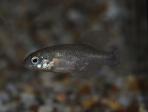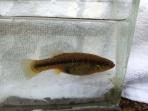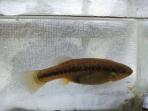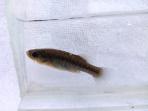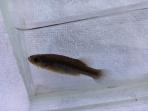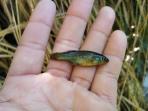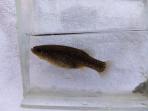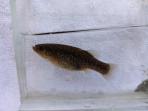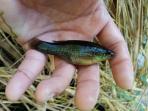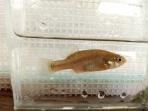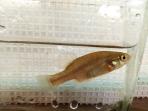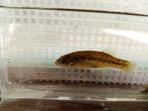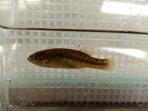Neoophorus regalis
ÁLVAREZ DEL VILLAR, J. (1959): Contribución al conocimiento del genero Neoophorus (Pisc., Goodeidae). Ciencia, Méx. 19 (1-3): pp 13-22
Collection-number: Escuela Nacional de Ciencias Biológicas, Cat. No. ENCB P892. The Holotype is an adult female of 76.5mm standard length, collected together with six Paratypes of 43 to 64.9mm standard length by the Mexican engineer Praxedis Francke Ramírez on August the 29th, 1958.Interestingely, in the same collection of the Instituto Politecnico Nacional (IPN) is a male Paratype deposited (Cat. No. ENCB P395) with the date of receipt given with May the 30th, 1956, though Álvarez del Villar registered all types were collected in 1958.
The left picture shows the female Holotype from the description of the species in 1959, the right one a male, photo taken by Dominic Isla, who rediscovered the species in 1993:
The types were collected "en las cercanias", which is spanish for "in the vicinity", of Los Reyes de Salgado in the federal state of Michoacán.
The species epithet is derived from the latin with the adjective "regalis" meaning royal. Álvarez del Villar chose it to refer to the town next to the type locality, Los Reyes de Salgado, which was founded in 1594 as Los Santos Reyes with this name being an allusion to the Biblical Magi. In 1859 the name was changed into Villa de Salgado after governor Don José Francisco Trinidad Salgado Rentería, who was born in this town. Finally in 1921 both named were officially brought together as Los Reyes de Salgado.
The genus Neoophorus was erected by C. L. Hubbs and C. L. Turner (in Turner, 1937) "on the basis of differences in the ovarian and trophotaenial characters". The generic name is derived from the ancient Greek. The word νέος (néos) means new or young and ᾠόν (óón) is the Greek term for egg. To carry something or to bear something is φόρος (phóros) in Greek, and together with the word egg it simply means "ovary". Neoophorus can therefore be translated with "a new type of ovary".
Alloophorus regalis Álvarez, 1970
Allotoca regalis Espinosa-Perez et al., 1993
The Balsas Allotoca is endemic to the Mexican federal states of Jalisco and Michoacán. It is historically known from the Río El Chivo drainage S of Los Reyes de Salgado, a Río Tepalcatepec affluent. It is also known from the Presa Tarécuato and the Ojo de Agua de Tocumbo in the Río Grande headwaters, and the Río Quitupan, an endorheic river about 45km NW of Tocumbo. All these collection points belong to the Cotija region, Río Grande headwaters, Río Balsas system. Known from two river drainages, two subpopulations can be inferred: the endorheic Río Quitupán subpopulation and the Río Grande subpopulation (type subpopulation). The bold names are the ones officially used by the Instituto Nacional de Estadística y Geografía; nevertheless, other ones might be more often in use or better known and therefore prefered.
ESU ist short for Evolutionarily Significant Unit. Each unit expresses an isolated population with different genetic characteristics within one species. ESU's can be defined by Molecular genetics, Morphology and/or Zoogeography and help in indicating different phylogenetic lineages within a species. The abbreviation for an ESU is composed of the first 3 letters of the genus, followed by the first 2 letters of the species name and an ongoing number in each species.
In Neoophorus regalis we do not distinguish any ESU`s. All fish belong to Neore1.
The left map shows the Río Tepalcatepec basin from the Hydrographic Region Balsas on a Mexico map, the right map the Río Itzícuaro (ITZ) subbasin:
International Union for Conservation of Nature (IUCN): Critically Endangered
Distribution and current conservation status of the Mexican Goodeidae (Lyons et al., 2019): Critically Endangered/declining: „At present, this species survives in only one small unnamed stream near the town of Los Reyes, Michoacán, in the upper Balsas River basin. Historically, the species was widespread and moderately common in streams and wetlands in the Valley of Los Reyes (Miller et al., 2005), but distribution and abundance have declined steadily during the last 25 years as wetlands have been drained and streams have been channelized and diverted for agriculture. Introductions of non-native Xiphophorus hellerii (Poeciliidae) and Oreochromis aureus (Cichlidae) may also have contributed to losses. As of 2000, N. regalis was known from four locations (Domínguez-Domínguez et al., 2005), but 2008 and 2011 surveys found the species at only one of these locations, where it was uncommon.“
NOM-059-SEMARNAT-2010: Categoría de riesgo (Category of risk): P - En Peligro de Extinción (in danger of extinction)
In Tocumbo, the species inhabited a spring fed pool, but after this habitat was modified into a concrete pool, the species disappeared. The habitats near Los Reyes, Quitupan and Tarécuato are spring fed pools as well, partly dammed and covered with Eichhornia, or slow flowing shallow creeks and rivers and small ditches with milky and turbid water. Vegetation is rare, besides riparian grass mainly water hyacinths and dense green algae stands. The water depth prefered by this species is less than 0.5m. in faster flowing rivers, Neoophorus regalis can be found usually in its quiet bays.
In 2020, on behalf of the GWG, I. Betancourt and D. Montejo surveyed several habitats of the Chorumo after last stocks of this species in Europe disappeared and the situation around the species was uncertain. They were able to find it in a shallow and slow flowing channel S of Los Reyes de Salgado between rocks and riparian vegetation. The ground was made of mud and gravel with rocks and boulders. West of the town, they were successful to find it in the Río El Chivo. The current of this small river was moderate to swift, the ground similar to the channel. The habitat was partly shaded by riparian grass and trees. The third habitat they surveyed was the spring next to Tarécuato, formerly known as "Aquiles Serdán" locality. The muddy spring fed pond, about one meter deep, was partly densely covered with Eichhornia and revealed quite a good stock of Neoophorus regalis. Only a month later, a GWG member from Slovakia was able to survey the habitat in Quitupan and was also sucessful in finding this species.
This species is one of the most unkown ones among Goodeids as only few observations in the wild have been made so far. The finding of gravid females in February 2020 indicate a breeding period that starts early in the year.
Due to the dentition of this species, similar to species of the closely related genus Allotoca, it probably feeds mainly on small insect larvae, shrimps, water fleas and worms.
The colouration of Neoophorus regalis is unique among Goodeids and has been described by Álvarez del Villar as "dark-gray on the dorsal part of the body down to the midline of the sides. The colour becomes clearer very fast till it looks whitish on the venter. No blotches or bars can be detected. The fins appear dark".
Males and females of the Balsas Allotoca are not easy to distinguish. The safest characteristic is the Splitfin in males, means the for Goodeinae typical mating organ formed by a notch after the first seven shortened rays of the Anal fin. Additionally, male Neoophorus regalis have a much bigger Dorsal fin than females. Both sexes display little colour and is not really possible to say that males are more colourful than females like in many other Goodeid species.
This species was believed to have disappeared in the wild for about 15 years, but was rediscovered by D. Isla and J. Mangan near Los Reyes de Salgado in 1993, and since this time it was found in several small habitats mainly south of the town of Los Reyes, in the endorheic Quitupan basin W of the Presa de San Juanico and in the Tarécuato spring near Aquiles Serdán. Last surveys of the area in 2020 were successful in finding the species in almost all the described habitats (for detailed information, go to the chapter Habitat). Sugar cane production and excessive water demand threaten each of these populations, therefore this species is in urgent need of being monitored in the wild and in need of being maintained in aquariums. As a reaction on the threats this species is facing, the Austrian Association of Aquarists (ÖVVÖ) started a Studbook on Neoophorus regalis and all Allotoca species.
Only eleven years after its description, Neoophorus regalis had been transfered to the genus Alloophorus by Álvarez del Villar (1970) because of a similar appearance of its trophotaenia. Staying quite mystique and overlooked, it took another 25 years before the relationship with Allotoca had been realized and quite recently Radda, Meyer and Dominguez refered this species again to the (now) monotypic genus Neoophorus (2001). However, the close relationship as a sister genus to Allotoca is encouraged by several studies.
The Goodeid fish fauna of the Cotija region originates mainly in the Río Lerma basin, where most of the species came from or related species can be found. The waters of the Cotija basin became redirected by a stream capture event and are now part of the Río Balsas drainage. While Goodea atripinnis, Alloophorus robustus and Skiffia multipunctata can be found in both drainages, Chapalichthys encaustus is replaced by its congener pardalis in the Cotija region. Neoophorus regalis represents an Allotoca relative in this region with the geographically closest being catarinae, and the only other Goodeid species in the area around Los Reyes is Ilyodon whitei, that has its origin in the Balsas river drainage where the Cotija region now belongs to.
Looking on the biotopes of Neoophorus regalis, they suggest the species may prefer a habitat with moderate to swift current, structured with gravel, rocks, roots, branches, fallen leaves and river bank vegetation. Fry is eaten in some cases, but it may depend on the quantity and quality of food and on the number of places to hide. When several different stages of juveniles occur, fry may be neglected, so it makes sense to add separate brought up fry to the group with a size of 1.5 or 2cm to provide these stages and get a flock breeding colony.
The recommended tank size is at least 100 liters, bigger tanks with a generous base and little height (25cm are enough) are better for sure. With rocks and vegetation in the corners and backside of the tank well structured tanks combined with some roots and/or wood seem to do best with this species. The current should be moderate or swift, especially as the species is adapted to a high oxygene level (at least 8mg/l).
In the wild, the species feeds mainly from small or middle-sized invertebrates like bloodworms or insect larvae, so feeding with similar food, water fleas, Mysids and other food from animalistic sources will be best for this predatory fish. In aquarium, it feeds also well from flake food, granulate and even tablets, additionally given Nauplia of Brine Shrimps are eaten greedy. The species is acting a bit shy.
Concerning water quality, this species is in need of bigger water changes (60-80% every week) like most of the Goodeids, especially river and spring inhabiting species, so an automatic water changing system can be helpful. Otherwise, in combination with constant temperatures higher than 24°C, fish may get sick, lose resistance against diseases and age too fast. So for keeping the strain healthy and strong, give the fish a rest during winter time with temperatures lower than 20°C for 2 or 3 months so they stop producing fry. Allotoca species can be kept down to temperatures of 15-16°C without problems for months, some species even lower. In spring, when the temperature slowly increases, they will start spawning at 20 or 21°C and won't stop until it gets colder again or when it gets too warm (25°C).
This species is doing very well when is kept in the open from spring to fall, starting when the water temperature by day exceeds 15°C and cold periods are no longer expected. Bring them out in the early afternoon, the time of the day with the highest water temperature. During the warm summer, reproduction will stop and may occur again in fall. Bring the fish in before the water temperature deceeds 15°C by day and keep them cool for the first days, then slowly raise the temperature but try to stay below 20°C over the winter time.





